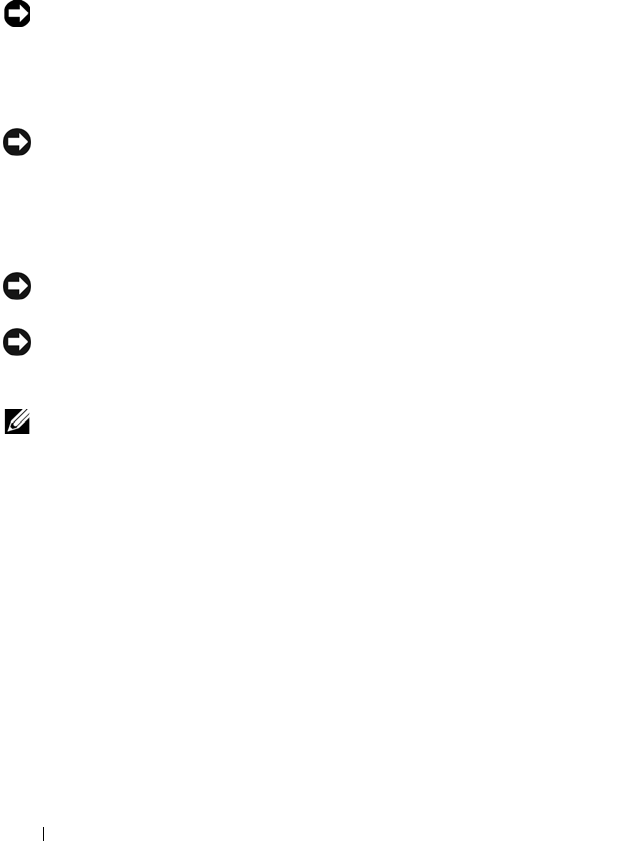Storage System Hardware Owner's Manual
Table Of Contents
- Hardware Owner’s Manual
- About Your System
- Using the System Setup Program
- Installing System Components
- Recommended Tools
- Inside the System
- Front Bezel
- Opening and Closing the System
- Hard Drives
- Replacing a Hard-Drive Carrier
- Power Supplies
- System Fans
- Cooling Shroud
- Fan Brackets
- Cable Routing
- SAS Controller Daughter Card
- Configuring the Boot Device
- Expansion Cards
- Expansion-Card Cage
- DRAC Card and Cables
- Optical Drive and Cable
- System Memory
- Activating the Integrated NIC TOE
- Processors
- System Battery
- Expansion-Card Riser Boards
- Sideplane Board
- SAS Backplane Board
- Control Panel Assembly (Service-only Procedure)
- System Board (Service-only Procedure)
- Troubleshooting Your System
- Safety First-For You and Your System
- Start-Up Routine
- Checking the Equipment
- Troubleshooting Basic I/O Functions
- Troubleshooting a NIC
- Troubleshooting a Wet System
- Troubleshooting a Damaged System
- Troubleshooting the System Battery
- Troubleshooting Power Supplies
- Troubleshooting System Cooling Problems
- Troubleshooting System Memory
- Troubleshooting an Optical Drive
- Troubleshooting an External SCSI Tape Drive
- Troubleshooting a Hard Drive
- Troubleshooting a SAS Controller Daughter Card
- Troubleshooting Expansion Cards
- Troubleshooting the Microprocessors
- Running the System Diagnostics
- Jumpers and Connectors
- Getting Help
- Glossary
- Index

76 Installing System Components
Power Supplies
Your system supports one or two power supplies rated at an output of 750 W.
If only one power supply is installed, it must be installed in the left power
supply bay (1). If two power supplies are installed, the second power supply
serves as a redundant, hot-plug power source.
NOTICE: To ensure proper system cooling, the power supply blank must be
installed on the unoccupied power supply bay in a non-redundant configuration.
See "Installing the Power Supply Blank" on page 78.
Removing a Power Supply
NOTICE: The system requires one power supply for the system to operate normally.
The system is in the redundant mode when two power supplies are installed and
both power supplies are connected to an AC power source. Remove and replace
only one power supply at a time in a system that is powered on. Operating the
system with only one power supply installed and without a power supply blank
installed for extended periods of time can cause the system to overheat.
NOTICE: If only one power supply is installed, it must be installed in the left power
supply bay (1).
NOTICE: If you connect the system to a power source in the range of 120 to 220
VAC, and if two power supplies are installed, the second power supply serves as a
redundant, hot-plug power source.
NOTE: On your rack system, you may have to unlatch and lift the cable
management arm if it interferes with power supply removal. For information about
the cable management arm, see the system’s Rack Installation Guide.
1
If your system has a single power supply, turn off the system and all
attached peripherals. For a redundant system, you can leave the system
running and proceed to the next step.
2
Disconnect the power cable from the power source.
3
Disconnect the power cable from the power supply and remove the cable
from the cable retention bracket.
4
Release the locking tab on the left side of the power supply by pressing in
toward the right, and rotate the power-supply handle up until the power
supply is released from the chassis. See Figure 3-7.
5
Pull the power supply straight out to clear the chassis.
Book.book Page 76 Monday, September 14, 2009 12:57 PM










